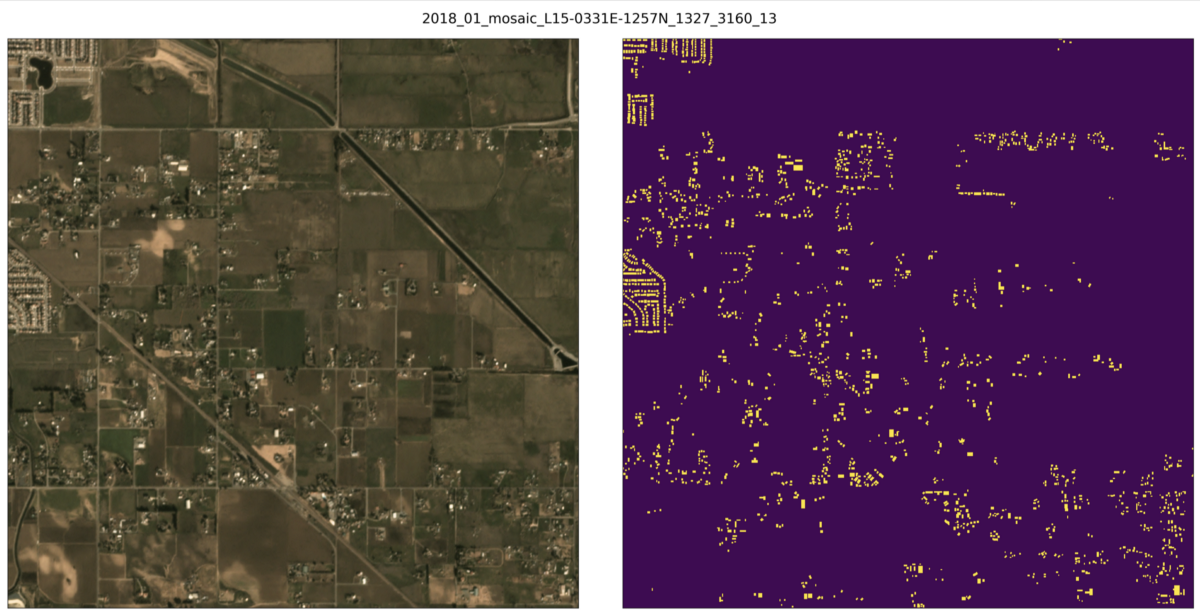
The ramp model requires training data over geographically diverse AOIs that will be used to build our “baseline” model, as well as concentrated training data over Bangladesh which will be used to “fine-tune” the baseline model to perform, in theory, better than the generalized baseline model. For example, devising a way to review what is available in a timely fashion, what defines a set that is “good enough” and making sure we have consistency in label quality across a variety of inputs are just some pieces of the puzzle. While satisfying these requirements may seem straightforward, there are nuances on what makes the best training data set. In this scenario, high-resolution means better than 60 cm, typically less than 15 degrees off nadir and nearly cloud-free. To train the model we prioritized access to publicly released high-resolution satellite/drone imagery and building rooftop labels. Maxar Open Data Program image over Kushalnagar, India with polygon labels over buildings. To maximize the quality of our training data, and our eventual model, we have researched past efforts to identify what is usable and created fresh training data in-house and through our partner Radiant Earth Foundation. An ML model will only be as good as the examples provided to train it, with a common phrase used in the AI/ML community – “garbage in, garbage out.” What this really means is that if you show your model many examples of buildings but the polygon outlines do not capture the entire building, or they include some nearby features like a backyard, animal pen, or roadway, then your model will start to get confused as to what a building is and is not. By feeding a machine learning model thousands of examples of buildings across the globe, eventually that model will be able to process a completely new image and identify all the buildings in that scene. The labels can be captured using any standard geospatial format including Shapefile, GeoJSON, and GeoPackage. These labels are broken into 256 pixel X 256 pixel training “chips” that will be fed into our model so it can learn what a building looks like, and ultimately detect buildings in fresh imagery. When we talk training data, we are referring to satellite and drone images that have vector labels covering the extents of buildings. The ramp project is an ambitious endeavor for many reasons, not the least of which is the curation and open release of high-quality training data in the form of tens of thousands of high-resolution imagery chips with accompanying labels that “teach” our machine learning model what a building looks like under various conditions. In case you missed it, check out our ramp intro blog to get a sense of what we’re looking to accomplish with this open AI initiative.
#Spacenet buildinglabels example how to
Creating our on-ramp: how to train a hungry AI model Furthermore, we think that solving this challenge is an important stepping stone to unleashing the power of advanced computer vision algorithms applied to a variety of remote sensing data applications in both the public and private sector.Above image: Maxar Open Data Program image over Dhaka, Bangladesh with polygon labels over buildings. We believe that advancing automated feature extraction techniques will serve important downstream uses of map data including humanitarian and disaster response, as observed by the need to map road networks during the response to recent flooding in Bangladesh and Hurricane Maria in Puerto Rico.
#Spacenet buildinglabels example manual
Today, map features such as roads, building footprints, and points of interest are primarily created through manual techniques.


CosmiQ Works, Radiant Solutions and NVIDIA have partnered to release the SpaceNet data set to the public to enable developers and data scientists to work with this data. One area for innovation is the application of computer vision and deep learning to extract information from satellite imagery at scale.

The commercialization of the geospatial industry has led to an explosive amount of data being collected to characterize our changing planet.


 0 kommentar(er)
0 kommentar(er)
